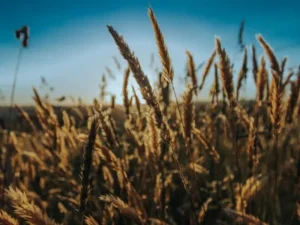Residue testing in grain looks at Organochlorines (OC), Organophosphates (OP) and Synthetic Pyrethroids (SP) which are chemical compounds that are used as insecticides. Organochlorines are a risk becaus e they persist in the environment and the fat of animals, thus posing a potential risk to public health. The chemical is concentrated in the fat of animals and the leaner the animal, the higher the level of concentration.
e they persist in the environment and the fat of animals, thus posing a potential risk to public health. The chemical is concentrated in the fat of animals and the leaner the animal, the higher the level of concentration.
The Maximum Residue Limits (MRLs) of OC’s in stockfeed is determined by consideration of this magnification of the residue. A significant proportion of contamination of animals with OC’s is derived from consumption of contaminated soil. There have been many instances of contamination of stored grains and forages with OC’s from timber treated with DDT.
It is not practical to use laboratory testing to determine the residue status of materials that have an unknown origin or treatment history. Usually testing will involve testing for presence of Organochlorine, organophosphorus (OP) type pesticides, Synthetic Pyrethroids (SP) Chlorfluazuron and others. An example of an OC, OP and SP residue test output is shown below:
Most OC detections in grain are related to soil contamination and diligence in reporting and testing has resulted in a reduced incidence of positive results while demand for testing for OP (organophosphorus), SP (synthetic pyrethroids) and fungicides has increased.
Some other definitions used in the laboratory analysis:
MRL (maximum residue limit)
The maximum residue limit is defined as the maximum concentration of a residue that is legally permitted or recognized as acceptable in or on a food, agricultural commodity or animal feed. It results from the officially authorised safe use of an agricultural or veterinary (agvet) chemical. The concentration is expressed in mg/kg (milligrams per kilogram or parts per million) of the commodity.
LOR (limit of reporting)
The limit of reporting is the minimum concentration (mg/kg) of a residue used for reporting purposes. A report would include a statement “Results of analyses lower than the LOR are not included in this report”. Each report is accompanied by a Chemical List that identifies each chemical and its respective LOR included in the assay. A result of “LOD (limit of detection)
LOD is also referred to as lowest detectable limit and is the lowest concentration of an analyte at which positive identification can be determined.
What are the reporting requirements with respect to LODs and LORs for National Residue Survey (NRS) Contract Laboratories?
- A contract laboratory should report to NRS quantitative results for analytes detected at concentrations above the laboratory’s method LORs, irrespective of the level at which the NRS specified LORs are set.
- In the case where an analyte is detected at a concentration between the method’s LOD and the method’s LOR the result should be reported as a ‘trace’ and entered into the database as (-1) against the relevant NRS chemical code.
- If neither of the above apply for an analyte included in a test done for the NRS, the laboratory should enter nothing against that analyte in the report.
What influences accuracy of the test result?
Sampling
The analysis result is only as good as the sample submitted. Taking a good, representative sample of the feedstuff being submitted is the most critical step in determining the accuracy of the final result. A sample needs to accurately reflect the nutritional/residue status of the total batch which maybe several tonnes.
The sample submitted to the laboratory must be a composite sub-sample from 12-20 samples taken across the product. A second sample should be kept on farm as a retention sample. The following provides a brief summary of sampling procedures depending on the target feedstuff and analysis being performed.
Grains and ingredients
Ideally a grain probe should be used to collect 12 – 20 random samples as grain is discharged or from various sites in flat bed storage. These should be combined in a clean plastic bucket and blended. Four sub-samples should be taken from the bucket with approx 250 grams taken from each to form the final sample for submission to the laboratory.
Total mixed rations
Collect only freshly blended rations. Grab12 – 20 handfuls of the mix from different locations across the feed bunk or in front of 12 – 20 animals. It is important to ensure that samples are taken through the mix – not just from the top few cms to ensure that the lesser particle size material which may have separated out is included in the sample. Once 12 – 20 samples have been collected, they should be blended in a bucket and sub-sampled as above to obtain the final sample.
Silage
Collect only freshly unloaded material. Grab 12 – 20 samples from random locations across the unloaded pile or feed bunk. For bunker or trench silos, obtain 12 – 20 samples across the freshly exposed face of the load. Sampling locations should vary from top to bottom and left to right. Combine, blend and sub-sample as suggested above.
Hay
A core sampler or hay probe will always provide a more representative sample of the total load than will taking samples by hand. Again, 12 – 20 samples should be collected randomly across the whole load.
Samples for Residue Testing
Delays in submission of sample for residue testing can affect the validity of the result. Biological activity and deterioration of specimens can occur either during storage or transport. Bacteria may die as samples dry, pesticides and antibiotics may break down. For this reason, it is important to submit samples without delay and contact the laboratory for assistance with regard to sample submission.
Recording of a sample
Grain and feed samples should be kept in an airtight container or bag in a cool, dry place, away from direct sunlight. Clearly label the sample with the following information:
- Assign a sample number. May include reference to number of samples submitted that day i.e. 1 of 5. The sample number should be recorded on farm against name of supplier and/or delivery docket, invoice number if a purchased grain sample. For purchased feed samples, the sample number would be recorded against invoice number or batch number for bagged feeds/concentrates.
- Customer or business name
- Name of feed
- Date sample taken
- Tests required. This information should be repeated on the analysis request form which would prompt for sample description (in this case a number and name), test and perhaps method code. The latter code may already appear on the request form.
An analysis request form should always accompany the samples. These can be obtained from the testing laboratory along with sample bags if required.
Grain Residue TEsting at Symbio
Contact our team today about grain residue testing and our other agricultural testing capabilities.


